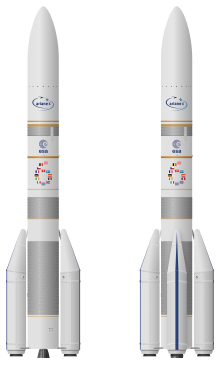Ariane 6
| Ariane 6 | |
|---|---|
| European launch vehicle under development | |
 | |
 Illustration of the two Ariane 6 variants planned, A62 (left) and A64 (right) | |
| Has use | Medium-heavy launch vehicle |
| Manufacturer | ArianeGroup |
| Country of origin | European Space Agency |
| Project cost | €3.6 billion[1] |
| Cost per launch | €75 million (Ariane 62) €115 million (Ariane 64)[2][3] |
| Size | |
| Height | 63 m (207 ft) |
| Diameter | 5.4 m (18 ft) |
| Mass | 530,000–860,000 kg (1,170,000–1,900,000 lb) |
| Stages | 2 |
| Capacity | |
| Payload to LEO | |
| Mass | A64: 21,650 kg (47,730 lb) A62: 10,350 kg (22,820 lb)[4] |
| Payload to GTO | |
| Orbital inclination | 6° |
| Mass | A64: 11,500 kg (25,400 lb) A62: 4,500 kg (9,900 lb)[4] |
| Payload to GEO | |
| Orbital inclination | 0° |
| Mass | A64: 5,000 kg (11,000 lb)[4] |
| Payload to SSO | |
| Orbital inclination | 97.4° |
| Mass | A64: 15,500 kg (34,200 lb) A62: 7,200 kg (15,900 lb)[4] |
| Payload to LTO | |
| Mass | A64: 8,600 kg (19,000 lb) A62: 3,500 kg (7,700 lb)[4] |
| Associated rockets | |
| Family | Ariane |
| Comparable | Vulcan Centaur, H3, Titan IV, Falcon 9, Falcon Heavy (reusable) |
| Launch history | |
| Status | In Development |
| Launch sites | Centre Spatial Guyanais |
| First flight | Q4 2023 (planned)[5] |
| Boosters – Equipped Solid Rocket | |
| No. boosters | 2 or 4 |
| Height | |
| Diameter | 3 m (9.8 ft) |
| Propellant mass | 142,000 kg (313,000 lb) |
| Powered by | P120 |
| Maximum thrust | 4,650 kN (1,050,000 lbf) each |
| Core stage – Lower Liquid Propulsion Module | |
| Height | |
| Diameter | 5.4 m (18 ft) |
| Propellant mass | 140,000 kg (310,000 lb) |
| Powered by | Vulcain 2.1 |
| Maximum thrust | 1,370 kN (310,000 lbf) |
| Propellant | LH2 / LOX |
| Upper stage – Upper Liquid Propulsion Module | |
| Height | |
| Diameter | 5.4 m (18 ft) |
| Propellant mass | 31,000 kg (68,000 lb) |
| Powered by | Vinci |
| Maximum thrust | 180 kN (40,000 lbf) |
| Propellant | LH2 / LOX |
Ariane 6 is a European expendable launch system. In 2023, it was being developed. It has been in development since the early 2010s by ArianeGroup. They were creating it for the European Space Agency (ESA). The system was being built to replace the Ariane 5. The stated reason for Ariane 6 was that is was half the cost of Ariane 5. The new system would also increase the maximum number of launches each year from six or seven to up to eleven.[6]
Ariane 6 is designed with two core stages. They are both powered by liquid hydrogen-liquid oxygen (hydrolox) engines. The first stage has a version of the Vulcain engine that is used on the Ariane 5. The second stage has a new design of the Vinci engine. Most of the lift-off thrust comes from solid rocket boosters attached to the first stage. There are two P120s on the Ariane 62 and four on the Ariane 64 variants. These are larger versions of the P80s used on the Vega rocket.
Description[change | change source]
Two versions of Ariane 6 are being created:
- Ariane 62 has two P120 solid boosters. It will weigh about 530 t (520 long tons; 580 short tons) at liftoff. This version is intended for government and scientific missions.[7] It can launch up to 4,500 kg (9,900 lb) into Geosynchronous transfer orbit (GTO) and 10,350 kg (22,820 lb) into LEO.
- Ariane 64 has four P120 boosters. It has a liftoff weight of about 860 t (850 long tons; 950 short tons).[8] This version is intended for commercial satellite launches.[7] It can launch up to 11,500 kg (25,400 lb) into GTO and 21,500 kg (47,400 lb) into LEO. Like Ariane 5, it will be able to launch two geosynchronous satellites together.
References[change | change source]
- ↑ "Media backgrounder for ESA Council at Ministerial Level" (Press release). ESA. 27 November 2014. Retrieved 24 March 2016.
- ↑ Rich, Smith (2 June 2018). "Europe Complains: SpaceX Rocket Prices Are Too Cheap to Beat". The Motley Fool. Retrieved 12 May 2020.
- ↑ Gallois, Dominique (1 December 2014). "Ariane 6, un chantier européen pour rester dans la course spatiale" [Ariane 6, a European site to remain in the space race]. Le Monde.fr (in French). Le Monde. Retrieved 18 February 2015.
- ↑ 4.0 4.1 4.2 4.3 4.4 Lagier, Roland (March 2021). "Ariane 6 User's Manual Issue 2 Revision 0" (PDF). Arianespace. Retrieved 29 December 2021.
- ↑ Foust, Jeff (19 October 2022). "Ariane 6 first launch slips to late 2023". SpaceNews. Retrieved 19 October 2022.
- ↑ Clark, Stephen (16 December 2015). "Q&A with Stéphane Israël, chairman and CEO of Arianespace". Spaceflight Now. Retrieved 2022-01-26.
When it comes to Ariane 64, we are at around US$90 to US$100 million, as opposed to Ariane 5, which is in terms of cost, around US$200 million. You see with the effort we're making, we want to reduce the cost around 40/50%, which is very ambitious.
- ↑ 7.0 7.1 Amos, Jonathan (3 December 2014). "Europe to press ahead with Ariane 6 rocket". BBC. Retrieved 25 June 2015.
- ↑ "Ariane 6 - Ariane Group". ArianeGroup. Retrieved 1 July 2017.
